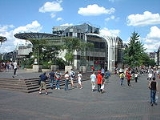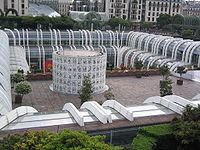
Les Halles
Encyclopedia

Paris
Paris is the capital and largest city in France, situated on the river Seine, in northern France, at the heart of the Île-de-France region...
, France
France
The French Republic , The French Republic , The French Republic , (commonly known as France , is a unitary semi-presidential republic in Western Europe with several overseas territories and islands located on other continents and in the Indian, Pacific, and Atlantic oceans. Metropolitan France...
, located in the 1er arrondissement, just south of the fashionable rue Montorgueil
Rue Montorgueil
Rue Montorgueil is a trendy street in the 2nd arrondissement of Paris, France. Lined with famous restaurants, quaint cafés, bakeries , fish stores, cheese shops, wine shops, produce stands and flower shops, rue Montorgueil has become recognized as one of the best places for hip Parisians to...
. It is named for the large central wholesale marketplace
Marketplace
A marketplace is the space, actual, virtual or metaphorical, in which a market operates. The term is also used in a trademark law context to denote the actual consumer environment, ie. the 'real world' in which products and services are provided and consumed.-Marketplaces and street markets:A...
, which was demolished in 1971, to be replaced with an underground modern shopping precinct, the Forum des Halles. It is notable in that the open air center area is below street level, like a sunken garden, and contains sculpture
Sculpture
Sculpture is three-dimensional artwork created by shaping or combining hard materials—typically stone such as marble—or metal, glass, or wood. Softer materials can also be used, such as clay, textiles, plastics, polymers and softer metals...
s, fountain
Fountain
A fountain is a piece of architecture which pours water into a basin or jets it into the air either to supply drinking water or for decorative or dramatic effect....
s, and mosaic
Mosaic
Mosaic is the art of creating images with an assemblage of small pieces of colored glass, stone, or other materials. It may be a technique of decorative art, an aspect of interior decoration, or of cultural and spiritual significance as in a cathedral...
s, as well as museums including the Musée Grévin - Forum des Halles
Musée Grévin - Forum des Halles
The Musée Grévin - Forum des Halles is a wax museum located in the Forum des Halles, level 1, in the Ier arrondissement at 1 Rue Pierre Lescot, Paris, France. It is open daily; an admission fee is charged....
(a wax museum
Wax museum
A wax museum or waxworks consists of a collection of wax sculptures representing famous people from history and contemporary personalities exhibited in lifelike poses....
).
Beneath this lies the underground station Châtelet-Les-Halles, a central hub of Paris's express commuter rail system, the RER
RER
The RER is a rapid transit system in France serving Paris and its suburbs. The RER is an integration of a modern city-centre underground rail and a pre-existing set of commuter rail lines. It has several connections with the Paris Métro within the city of Paris. Within the city, the RER...
.
History
Les Halles was the traditional central market of Paris. In 1183, King Philippe II AugustePhilip II of France
Philip II Augustus was the King of France from 1180 until his death. A member of the House of Capet, Philip Augustus was born at Gonesse in the Val-d'Oise, the son of Louis VII and his third wife, Adela of Champagne...
enlarged the marketplace in Paris and built a shelter for the merchants, who came from all over to sell their wares. In the 1850s, the massive glass and iron buildings (Victor Baltard
Victor Baltard
Victor Baltard , French architect, who was born in Paris, son of architect Louis Baltard.Until 1833, Baltard studied at the École des Beaux-Arts, where he garnered the Prix de Rome for designing a military school in 1833...
Architect) Les Halles became known for were constructed. Les Halles was known as the "belly of Paris".
Unable to compete in the new market economy and in need of massive repairs, the colorful ambience once associated with the bustling area of merchant stalls disappeared in 1971, when Les Halles was dismantled; the wholesale market was relocated to the suburb of Rungis
Marché d'Intérêt National de Rungis
The Marché International de Rungis is the principal market of Paris, located in the commune of Rungis, in the southern suburbs. It is the largest wholesale food market in the world....
.
The site was to become the point of convergence of the RER
RER
The RER is a rapid transit system in France serving Paris and its suburbs. The RER is an integration of a modern city-centre underground rail and a pre-existing set of commuter rail lines. It has several connections with the Paris Métro within the city of Paris. Within the city, the RER...
, a network of new express underground lines which was completed in the 1960s. Three lines leading out of the city to the south, east and west were to be extended and connected in a new underground station. For several years, the site of the markets was an enormous open pit, nicknamed "le trou des Halles" (trou = hole), regarded as an eyesore
Eyesore
An eyesore is an unpleasant view. Its technical usage is as an alternative perspective to the notion of landmark. Common examples include dilapidated buildings, graffiti, litter, polluted areas and excessive commercial signage such as billboards. Some eyesores may be a matter of opinion such as...
at the foot of the historic church of Saint-Eustache
Église Saint-Eustache, Paris
L’église Saint-Eustache is a church in the 1st arrondissement of Paris, built between 1532 and 1632.Situated at the entrance to Paris’s ancient markets and the beginning of rue Montorgueil, the Église de Saint-Eustache is considered a masterpiece of late Gothic architecture...
.
Construction was completed in 1977 on Châtelet-Les-Halles, Paris's new urban railway hub. The Forum des Halles, a partially underground multiple story commercial and shopping center, opened in 1979. The building was criticized for its design and in recent years the city of Paris has undertaken consultations regarding the remodeling of the area.
Trivia
Part of the actual demolition of the site is featured in the film Touche Pas de la Femme Blanche (Don't Touch the White Woman!Don't Touch The White Woman!
Don't Touch The White Woman! is a 1974 French-Italian farce, an absurd "Western" set in Paris, directed by Marco Ferreri. Marcello Mastroianni stars as a vain General George Armstrong Custer. Richard Nixon is the American president. Buffalo Bill Cody is here portrayed as a charlatan media impresario...
), which iconaclastically restages General Custer's 'last stand' in a distinctly French context in and around the area.

